Stomach of a person, pictures, structure, functions
The stomach of a person , gaster (ventriculus), is located in the upper left (5/6) and in the right (1/6) parts of the abdominal cavity; Its long axis runs on the left from above and from behind to the right down and forward and is almost in the frontal plane. The shape and dimensions of the stomach are variable and depend on the degree of its filling, the functional state of the musculature of its walls (contraction, relaxation). 
Stomach of a person.
The shape of the stomach also varies with age. It is accepted to distinguish three forms of the stomach: the shape of the horn, the shape of the stocking and the shape of the hook.
The left part of the stomach is located on the left under the diaphragm, and the narrow right - under the liver. The length of the stomach along its long axis is on average 21-25 cm. The stomach capacity is 3 liters.
Parts of the stomach.
The stomach consists of several parts: the cardial, the bottom (arch), the body and the pyloric (pyloric). The entrance, or cardiac part, pars cardiaca, begins with a hole through which the stomach communicates with the esophagus - the cardial opening, ostium cardiacum.
Directly to the left of the cardial part is the convex upward bottom of the stomach (fundus) of the stomach, the fundus (fornix) gastricus.
The largest part of the stomach - up to the top without sharp boundaries continues into the bottom, and to the right, gradually narrowing, passes into the pyloric part.
The pyloric part, pars pylorica, directly adjoins the orifice of the gatekeeper, ostium pyloricum, through which the lumen of the stomach communicates with the lumen of the duodenum.
The pyloric part is divided into the cave of the gatekeeper, the antrum pyloricum, and the canalis pyloricus canalis, equal in diameter to the adjacent duodenum, and the pylorus, the pylorus, of the gastric region passing into the duodenum, at which level the layer of circular muscular bundles thickens, forming Sphincter of the pylorus, m. Sphincter pyloricus.
The cardiac part, the bottom and the body of the stomach are directed from top to bottom and to the right: the pyloric part is located at an angle to the body from below upwards and to the right. The body at the border with the cave of the gatekeeper forms the narrowest part of the cavity.
The described form of the stomach, observed during X-ray examination, resembles a hook in shape, it occurs most often. The stomach can have the shape of a horn, while the position of the body of the stomach approaches the transverse, and the pyloric part constitutes the extension of the body, without forming an angle with it.
The third form of the stomach is the shape of the stocking. For a stomach of this form, a vertical position and a long body are typical, the lower edge of which is at level IV of the lumbar vertebra, and the pyloric part is at the level of the II lumbar vertebra along the midline.
The anterior surface of the stomach is its anterior wall, paries anterior, facing posteriorly - posterior wall, paries posterior. The upper edge of the stomach, which forms the boundary between the anterior and posterior walls, is arcuate, it is shorter and forms a small curvature of the stomach, curvatura gastrica (ventriculi) major.
Small curvature on the border of the body of the stomach and the pyloric part forms an angular notch, incisura angularis; By the large curvature of the sharp boundary between the body of the stomach and the gatekeeper is not. Only during the digestion of food the body is separated from the gatekeeper's part (cave) by a deep fold, which can be seen during X-ray examination. Such a constriction is usually visible on the corpse. By the large curvature there is a notch separating the cardial part from the bottom, a cardial notch, incisura cardiaca.
The casings of the stomach.
The wall of the stomach consists of three membranes: the external - the peritoneum (serous membrane), the middle - the muscular and the inner - the mucosa.
The serous membrane, tunica serosa, is a peritoneal sheet of the peritoneum and covers the stomach from all sides; Thus, the stomach is located intraperitoneally (intraperitoneally). Below the peritoneum there is a hot, under-serous base, tela subserosa, through which the serous membrane fuses with the muscular membrane, tunica muscularis. Uncovered serosa cover only narrow strips of small and large curvature, where the peritoneal sheets that cover the anterior and posterior walls converge, forming the peritoneal ligament of the stomach. Here, along one and the other curvature, between the leaves of the peritoneum lie the blood and lymphatic vessels, the nerves of the stomach and the regional lymph nodes. The peritoneum is also not covered by a small portion of the posterior wall of the stomach to the left of the cardial part, where the wall of the stomach contacts the diaphragm.
The peritoneum, passing from the stomach to the diaphragm and to neighboring organs, forms a series of ligaments, which are discussed in the section "Peritoneum."
The muscular membrane of the stomach, tunica muscularis, consists of two layers: longitudinal and circular, and also of oblique fibers.
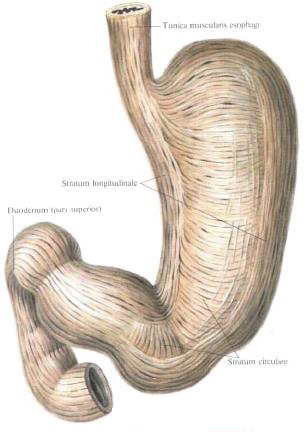
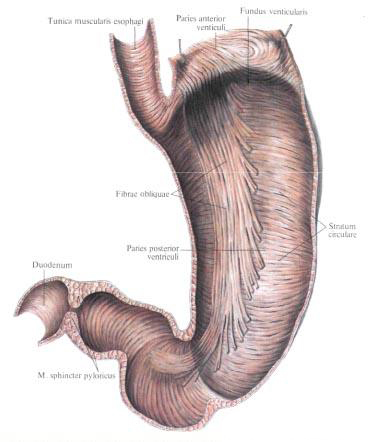
The outer, longitudinal, stratum longitudinale, representing the continuation of the same layer of the esophagus, has the largest thickness in the region of low curvature. In the place of transition of the body into the porcine part (incisura angularis), its fibers fan out in a fanlike manner on the anterior and posterior walls of the stomach and are weaved into bundles of the next - circular - layer. In the region of great curvature and the bottom of the stomach, the longitudinal muscle bundles form a thinner layer, but occupy a wider area.
The circular layer, stratum circulars, is the continuation of the circular layer of the esophagus. It is a continuous layer that covers the stomach throughout its entire length. A slightly weaker circular layer is expressed in the bottom region; At the level of the gatekeeper, he forms a significant thickening - the sphincter of the doorkeeper, m. Sphincter pyloricus.
Inside the circular layer are oblique fibers, fibrae obliquae. These beams do not represent a continuous layer, but form separate groups; In the area of the entrance to the stomach, bundles of oblique filaments loop around it, passing to the front and back surfaces of the body. The contraction of this muscle loop causes the presence of a cardial notch, insicura cardiaca. Near the small curvature oblique beams take a longitudinal direction.
The mucous membrane, tunica mucosa, like the muscle layers, is a continuation of the mucosa of the esophagus. A well-defined strip of dentate form represents the boundary between the epithelium of the mucosa of the esophagus and stomach. At the level of the gatekeeper according to the position of the pulp, the mucosa forms a permanent fold. The gastric mucosa has a thickness of 1.5-2 mm; It forms numerous folds of the stomach, plicae gastricae, mainly on the back wall of the stomach.
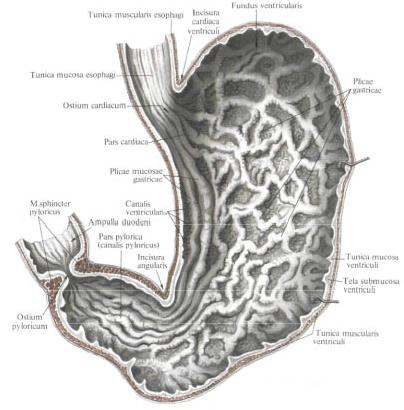
The folds have different length and different directions: near the small curvature there are long longitudinal folds that delineate the smooth portion of the mucous membrane of the curvature area - the canal of the stomach, canalis ventricularis, which mechanically directs the food lump into the pylorus cave. In the remaining parts of the stomach wall, they have a diverse direction, with longer folds that are joined together shorter. The direction and number of longitudinal folds are more or less constant, and in a living person the folds are well defined by X-ray examination with contrast masses. When the stomach is stretched, the folds of the mucosa are smoothed out.
The mucous membrane of the stomach has its own muscular plate of the mucous membrane, lamina muscularis mucosae, separated from the muscular membrane by a well-developed friable submucosa, tela submucosa; The presence of these two layers causes the formation of folds.
The gastric mucosa is divided into small, 1-6 mm in diameter, areas - gastric fields, areae gastricae. In the margins there are indentations - gastric dimples, foveolae gastricae, having a diameter of 0.2 mm; Dimples are surrounded by villous folds, plicae villosae, which are more pronounced in the area of the gatekeeper. In each dimple open the openings of 1-2 ducts of the gastric glands.
There are gastric glands (own), glandulae gastricae (propriae), located in the bottom and body, cardial glands, glandulae cardiacae, as well as pyloric glands, glandulae pyloricae. If the cardiac glands of the stomach are branched tubular in structure, the pyloric glands are simple mixed alveolar-tubular. In the mucosa (mainly in the pyloric part) lie the lymph follicles.
Topography of the stomach .
Most of the stomach is located to the left of the median plane of the body. The projection of the stomach on the anterior wall of the abdomen occupies the left hypochondrium and epigastric region.
Skeleototopically, the entrance to the stomach lies to the left of the vertebral column at level X or XI of the thoracic vertebra, the exit to the right of the spine, at the level of the XII thoracic or I lumbar vertebra.
The upper (vertical, hook-shaped) section of small curvature is located along the left edge of the vertebral column, its lower section intersects the vertebral column from left to right.
The back wall of the stomach in the bottom area is adjacent to the spleen; On the rest of the length it adjoins the organs located on the back wall of the abdomen: the left adrenal gland, the upper end of the left kidney, the pancreas, the aorta and the vessels that leave it.
The stomach is shifted by breathing and depending on the filling of neighboring hollow organs (transverse colon). The least movable points of the yolk are the cardiac and pyloric parts, the remaining parts differ considerably in displacement. The lowest point (the lower pole) is of great curvature with the hook-shaped form of the stomach and its more vertical position sometimes. It reaches the level of the line between the iliac crests and is located below it.
The bottom of the stomach is located under the dome of the left half of the diaphragm. The small curvature and the upper portion of the anterior wall adjoin the visceral surface of the left lobe of the liver.
The lower anterior surface of the body and the pyloric part of the stomach is attached to the rib side of the diaphragm and to the anterior abdominal wall in the region of the epigastrium. The left portion of great curvature abuts the visceral surface of the spleen; On the remaining length (to the right) it is attached to the transverse colon. If the stomach is in the shape of a horn and takes a more transverse position, the greater curvature is located at the level of the line connecting the ends of the X ribs, or at the level of the umbilical ring.
Innervation and blood supply of the stomach.
Innervation: branches n. Vagus and truncus sympathies. Form; Not plexus gastrici (plexus celiacus).
Blood supply: from the side of small curvature - from anastomosing with each other a. Gastrica dextra (from a.hepatica propria) and a. Gastrica sinistra (from truncus celiacus): from the side of great curvature - also from ana to anastomosing with each other. Gastroepiploicae dextra (from a. gastroduodenalis) and a. Gastroepiploica sinistra (from a. Lienalis); In the bottom area, fit aa. Gasiricae breves (from a. Lienalis). Venous blood flows from the same veins that flow into the system v. Portae. Lymph from the walls of the stomach flows into the regional lymph nodes, located mainly by small and large curvature. Lymphatic vessels from the cardial part, as well as from the adjacent sections of the anterior and posterior walls and the half of the bottom of the stomach, approach the cardinal nodes (anulus lymphaticus cardiust) from the small curvature and the adjacent area of the walls in the nodi lymphatici gastrici sinistri; From the pyloric part - in nodi lymphatici gastrici dextri, hepatici and pylorici; From great curvature - in the nodi lymphatici gastroomentales dextri et sinistri.
You will be interested to read this:


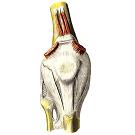
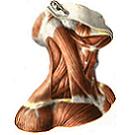
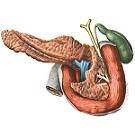


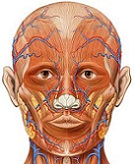

Comments
When commenting on, remember that the content and tone of your message can hurt the feelings of real people, show respect and tolerance to your interlocutors even if you do not share their opinion, your behavior in the conditions of freedom of expression and anonymity provided by the Internet, changes Not only virtual, but also the real world. All comments are hidden from the index, spam is controlled.